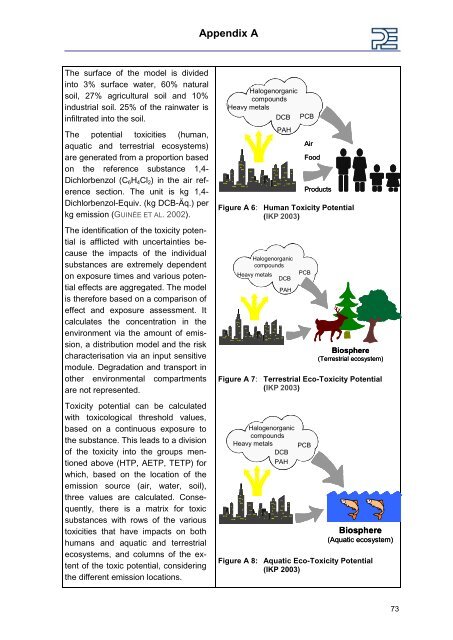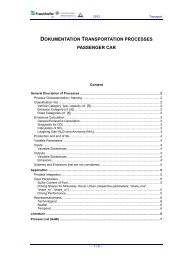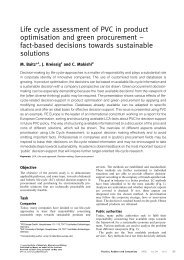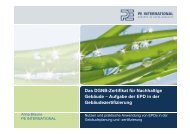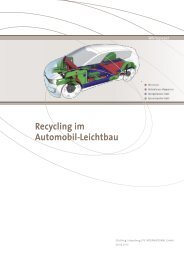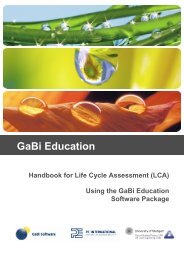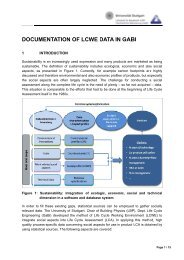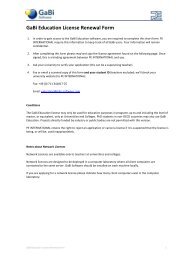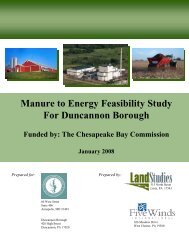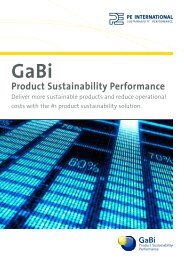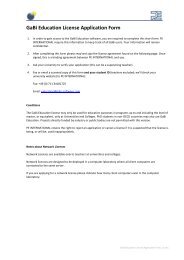GaBi Paper Clip Tutorial - GaBi Software
GaBi Paper Clip Tutorial - GaBi Software
GaBi Paper Clip Tutorial - GaBi Software
Create successful ePaper yourself
Turn your PDF publications into a flip-book with our unique Google optimized e-Paper software.
The surface of the model is divided<br />
into 3% surface water, 60% natural<br />
soil, 27% agricultural soil and 10%<br />
industrial soil. 25% of the rainwater is<br />
infiltrated into the soil.<br />
The potential toxicities (human,<br />
aquatic and terrestrial ecosystems)<br />
are generated from a proportion based<br />
on the reference substance 1,4-<br />
Dichlorbenzol (C6H4Cl2) in the air reference<br />
section. The unit is kg 1,4-<br />
Dichlorbenzol-Equiv. (kg DCB-Äq.) per<br />
kg emission (GUINÉE ET AL. 2002).<br />
The identification of the toxicity potential<br />
is afflicted with uncertainties because<br />
the impacts of the individual<br />
substances are extremely dependent<br />
on exposure times and various potential<br />
effects are aggregated. The model<br />
is therefore based on a comparison of<br />
effect and exposure assessment. It<br />
calculates the concentration in the<br />
environment via the amount of emission,<br />
a distribution model and the risk<br />
characterisation via an input sensitive<br />
module. Degradation and transport in<br />
other environmental compartments<br />
are not represented.<br />
Toxicity potential can be calculated<br />
with toxicological threshold values,<br />
based on a continuous exposure to<br />
the substance. This leads to a division<br />
of the toxicity into the groups mentioned<br />
above (HTP, AETP, TETP) for<br />
which, based on the location of the<br />
emission source (air, water, soil),<br />
three values are calculated. Consequently,<br />
there is a matrix for toxic<br />
substances with rows of the various<br />
toxicities that have impacts on both<br />
humans and aquatic and terrestrial<br />
ecosystems, and columns of the extent<br />
of the toxic potential, considering<br />
the different emission locations.<br />
Appendix A<br />
Halogenorganic<br />
compounds<br />
Heavy metals<br />
DCB PCB<br />
PAH<br />
Air<br />
Food<br />
Products<br />
Figure A 6: Human Toxicity Potential<br />
(IKP 2003)<br />
Halogenorganic<br />
compounds<br />
Heavy metals<br />
DCB<br />
PAH<br />
PCB<br />
Biosphere<br />
(Terrestrial ecosystem)<br />
Figure A 7: Terrestrial Eco-Toxicity Potential<br />
(IKP 2003)<br />
Halogenorganic<br />
compounds<br />
Heavy metals PCB<br />
DCB<br />
PAH<br />
Biosphere<br />
(Aquatic ecosystem)<br />
Figure A 8: Aquatic Eco-Toxicity Potential<br />
(IKP 2003)<br />
73


